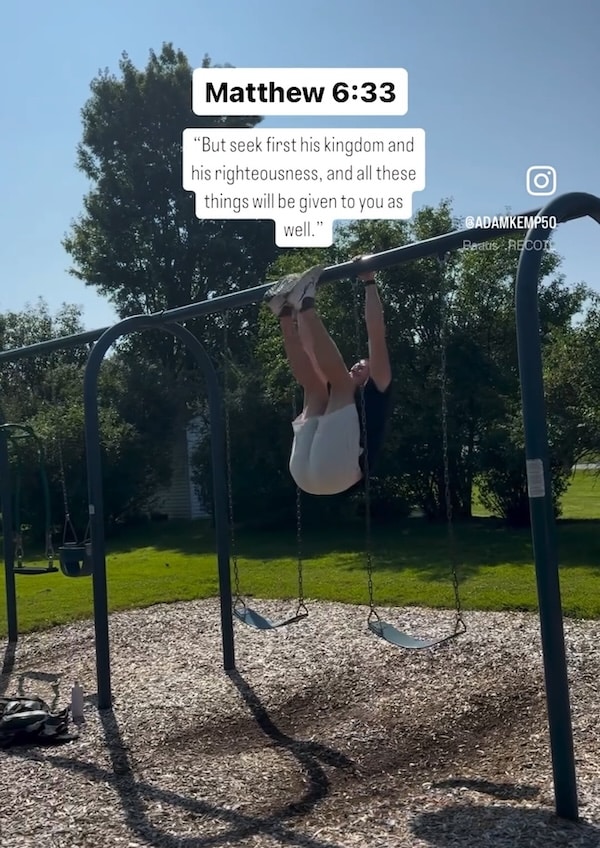Toes-to-Bar Exercise Guide: Benefits, How to Do & More!
Toes-to-Bar is a dynamic and challenging exercise that targets multiple muscle groups, making it a staple in CrossFit and advanced core training routines. By engaging your entire core, shoulders, and even your grip, this movement is a powerhouse for building strength and improving overall athleticism.
As a 6’10” professional basketball player, I’ve been incorporating Toes-to-Bar into my workouts since college, and even at 33 years old, I continue to find it an invaluable part of my training.
Despite my height, which adds an extra challenge to many bodyweight exercises, Toes-to-Bar has consistently helped me maintain a strong core and has contributed significantly to my back health.
The unique dynamic nature of this exercise requires careful execution, but when performed correctly, it can yield impressive results for athletes of all sizes.
Benefits of Toes-to-Bar
Toes-to-Bar offers several key benefits that make it an invaluable exercise for anyone looking to enhance their core strength and functional fitness:
- Core Strength: This exercise directly targets the rectus abdominis, obliques, and deeper core muscles, helping to build a solid and powerful midsection.
- Improved Grip Strength: Holding onto the bar while performing the movement requires significant grip strength, which is beneficial for various other exercises and sports.
- Enhanced Athleticism: Toes-to-Bar demands coordination, flexibility, and body control, all of which contribute to better overall athletic performance.
- Functional Fitness: By simulating a hanging leg raise, this exercise mimics movements that are functional in daily life and sports, such as climbing or hanging.
Muscles Worked
Toes-to-Bar is a comprehensive exercise that engages several key muscle groups:
- Core Muscles: Primarily targets the rectus abdominis, obliques, and the deeper transverse abdominis.
- Hip Flexors: The iliopsoas and rectus femoris are heavily involved in lifting the legs.
- Shoulders and Lats: The lats, shoulders, and scapular stabilizers work to maintain control and stability during the movement.
- Forearms and Grip: The sustained hold on the bar challenges the forearm muscles and grip strength.
How to Do Toes-to-Bar
- Starting Position: Hang from a pull-up bar with a shoulder-width grip, arms fully extended. Your body should form a straight line, and your feet should be off the ground.
- Engage Your Core: Begin by engaging your core and lats, slightly pulling your shoulders down and back.
- Initiate the Movement: With control, lift your legs while keeping them straight, aiming to bring your toes to touch the bar. Use a slight kip (a controlled swing) if necessary to generate momentum.
- Touch the Bar: As your legs rise, keep your core tight and bring your toes toward the bar, ensuring they make contact.
- Lower with Control: Slowly lower your legs back to the starting position, avoiding any swinging or loss of control.
Safety Tips
Toes-to-Bar is an advanced core exercise that offers significant benefits but also comes with risks if not performed correctly. This movement requires strong core muscles, healthy shoulders, and robust hip flexors, making it crucial to develop these areas before attempting the exercise.
One of the criticisms of CrossFit is that it sometimes pushes participants to perform intense exercises like Toes-to-Bar too soon, leading to potential injuries. To safely incorporate this exercise into your routine, it’s essential to warm up properly, control your movements, and progress gradually, ensuring your body is fully prepared for the demands of the exercise.
- Warm-Up Properly: Engage in a thorough warm-up focusing on shoulder mobility and core activation to prepare your body for the exercise.
- Control Your Movements: Avoid excessive swinging or using momentum to lift your legs, as this can lead to poor form and potential injury.
- Use Proper Grip: Ensure a strong, secure grip on the bar to prevent slipping, and consider using chalk or gloves if needed.
- Listen to Your Body: If you experience any pain in your shoulders, lower back, or wrists, stop and assess your form or consider a regression.
Progressions and Regressions
Toes-to-Bar can be adjusted to suit different fitness levels through progressions and regressions:
- Regressions:
- Hanging Knee Raises: Instead of lifting straight legs, bend your knees and bring them towards your chest. This reduces the difficulty while still engaging your core.
- Hanging Leg Raises: A step up from knee raises, this involves lifting your legs straight but stopping at a 90-degree angle with your hips.
- Progressions:
- Strict Toes-to-Bar: Perform the exercise without any kipping motion, relying solely on core strength to lift your legs.
- Weighted Toes-to-Bar: Add ankle weights or hold a dumbbell between your feet to increase the resistance.
Core training is essential for building a strong and stable midsection. Alternatives to crunches, such as the Toes-to-Bar exercise, offer a dynamic way to engage multiple muscle groups while avoiding strain on the neck and back.
Incorporating Toes-to-Bar into your training routine can lead to significant gains in core strength, grip, and overall athleticism.
This website does not provide medical advice. This website site does contain affiliate links, and purchases may earn a commission.
Read my Medical Disclaimer, Review Disclaimer, and Publishing Policies for more details. Use of this site indicates acceptance of these terms.




